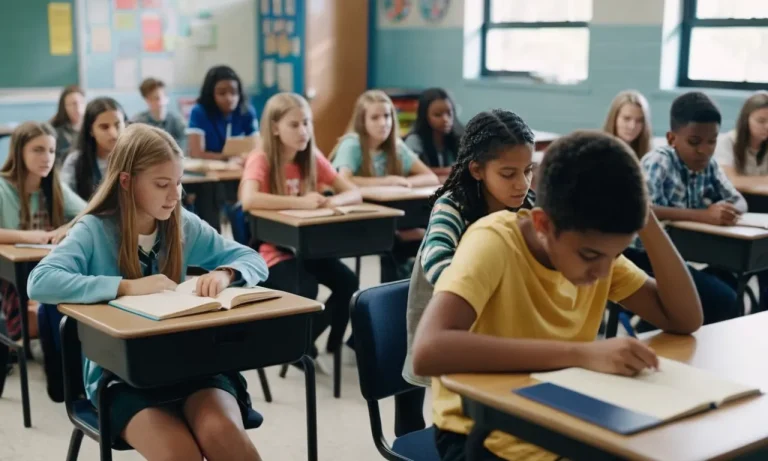Ah, middle school – the dreaded years that strike fear into the hearts of students and parents alike. It’s a time of awkward transitions, raging hormones, and social pressures that can make even the most confident kid feel like they’re navigating a minefield.
If you’re short on time, here’s a quick answer to your question: Middle school is often considered the worst due to a combination of physical, emotional, and social changes that occur during this pivotal stage of development, coupled with the challenges of transitioning from elementary to secondary education.
In this comprehensive article, we’ll delve into the various factors that contribute to the notorious reputation of middle school. From the emotional rollercoaster of puberty to the social dynamics of cliques and bullying, we’ll explore the reasons why these years can be particularly challenging for many students.
The Emotional Turmoil of Puberty
Hormonal Changes and Mood Swings
Ah, the joys of puberty! 🙄 During middle school years, young teens experience a whirlwind of hormonal changes that can make them feel like they’re on an emotional rollercoaster. According to HealthyChildren.org, the hormones estrogen and testosterone surge during puberty, causing mood swings, irritability, and intense emotions.
One minute they’re happy, the next they’re crying over a spilled glass of milk. It’s a confusing time, but don’t worry – it’s all part of the process!
Body Image Concerns
As their bodies undergo rapid changes, middle schoolers often become hyper-aware of their appearance. They may feel self-conscious about their weight, height, acne, or other physical changes. According to a study by The Dove Self-Esteem Project, a staggering 80% of girls have experienced body image issues by the age of 13.
It’s a crucial time for parents and educators to promote positive body image and self-acceptance. After all, these awkward years are just a phase – and a beautiful butterfly is emerging! 🦋
Developing Self-Identity
Middle school is a pivotal time for self-discovery and identity formation. Young teens are trying to figure out who they are, what they believe in, and where they fit in. They may experiment with different styles, interests, and friend groups as they navigate this journey.
It’s a time of questioning, rebellion, and exploring independence. According to the American Psychological Association, a strong sense of identity can help adolescents develop resilience and cope with life’s challenges. So, while it may be a bumpy ride, it’s an essential process for personal growth.
Let’s face it, middle school can be a tough time, but it’s also a time of incredible growth and self-discovery. With patience, support, and a good dose of humor, we can help our young teens navigate this turbulent phase and emerge as confident, self-aware individuals.
After all, as the saying goes, “What doesn’t kill you makes you stronger” – and middle school is definitely a strength-building experience! 💪
The Social Minefield
Middle school can be a tumultuous time for many students, as they navigate the complex social landscape that often feels like a minefield. This period of life is marked by significant physical, emotional, and social changes, making it a challenging phase for young individuals.
Here’s a closer look at some of the social hurdles that can make middle school a daunting experience.
Cliques and Peer Pressure
One of the most prevalent issues in middle school is the formation of cliques and the intense peer pressure that comes with it. These tight-knit social groups can create a sense of exclusion and foster an environment where conformity is valued over individuality.
According to a study by the Centers for Disease Control and Prevention, around 28% of middle school students reported experiencing bullying, often fueled by the desire to fit in with a particular clique.
This pressure to conform can lead to unhealthy behaviors, compromised self-esteem, and even academic struggles.
Bullying and Cyberbullying
Bullying, both in-person and online, is a significant concern in middle school. According to StopBullying.gov, approximately 20% of students aged 12-18 experience bullying nationwide. Middle school is a particularly vulnerable time, as students navigate changing social dynamics and establish their identities.
Cyberbullying, in particular, has become a pervasive issue, with social media and online platforms providing new avenues for harassment and intimidation. The impact of bullying can be far-reaching, leading to anxiety, depression, and even suicidal ideation in severe cases.
Navigating Friendships and Relationships
Middle school is often the time when students begin to explore romantic relationships and navigate the complexities of friendships. As hormones surge and emotions run high, maintaining healthy relationships can be a significant challenge.
According to a study by the American Psychological Association, nearly 60% of middle school students reported experiencing some form of dating violence or abuse. Additionally, the dynamics of friendships can shift rapidly during this period, leading to feelings of confusion, betrayal, and loneliness.
Navigating the social minefield of middle school requires resilience, self-awareness, and support from trusted adults. Parents, teachers, and counselors play a crucial role in helping students develop healthy coping mechanisms, build self-confidence, and foster positive relationships.
By addressing these social challenges head-on, we can help ensure that middle school is not just a period of survival but also a time of growth and personal development.
The Academic Transition
Transitioning to middle school often presents a significant academic challenge for many students. The shift from a single classroom environment with one primary teacher to navigating multiple classrooms and instructors can be overwhelming.
This adjustment period is a crucial phase that can shape a student’s academic trajectory and set the stage for their future success.
Adjusting to Multiple Teachers and Subjects
In middle school, students are exposed to a diverse range of subjects, each taught by a specialized teacher. This change from the elementary school model requires students to adapt to different teaching styles, classroom expectations, and grading criteria.
According to a study by the Education Week, nearly 60% of students struggle with this transition during their first year of middle school. 😕 The ability to build relationships with multiple teachers and understand their unique expectations is a crucial skill that students must develop.
Increased Workload and Expectations
Along with the adjustment to multiple teachers comes an increase in the overall workload and academic expectations. Middle school curriculum often introduces more complex concepts and requires a higher level of critical thinking and problem-solving skills.
Students are expected to manage assignments, projects, and exams across various subjects simultaneously. According to a survey by the National Association of Elementary School Principals, over 70% of middle school students report feeling overwhelmed by the increased academic demands.
😰 Developing effective time management and organizational skills becomes paramount during this phase.
Developing Study Skills and Time Management
The transition to middle school is an opportune time for students to cultivate essential study skills and time management strategies. As the workload intensifies and the content becomes more challenging, students must learn to prioritize tasks, create study schedules, and develop effective note-taking techniques.
Seeking help from teachers, counselors, or peer tutors can be invaluable in navigating this new academic landscape. Platforms like Khan Academy and Study Guides and Strategies offer valuable resources and tips for developing these crucial skills.
👍 By mastering time management and study habits, students can lay a solid foundation for academic success in middle school and beyond.
Navigating the academic transition to middle school can be daunting, but with the right support and strategies, students can overcome these challenges and thrive. Embracing the opportunity to develop new skills, seek help when needed, and maintain a positive mindset can make this phase a stepping stone towards future academic achievements.
🎉
The Physical Environment
Ah, middle school – a time of awkward growth spurts, hormonal changes, and the dreaded transition to a larger and more intimidating school environment. This phase can be a daunting experience for many students, and the physical surroundings themselves play a significant role in contributing to the overall sense of unease and discomfort.
Larger School Size and Crowded Hallways
One of the most striking differences between elementary and middle school is the sheer size of the school building. According to a study by the National Center for Education Statistics, the average middle school in the United States has an enrollment of around 600 students, compared to just 400 in elementary schools.
This increased population translates to crowded hallways, bustling stairwells, and a sense of chaos that can be overwhelming for young minds. Navigating through these crowded spaces, often while carrying heavy backpacks and rushing to make it to class on time, can be a stressful and anxiety-inducing experience for many students.
Navigating Class Schedules and Lockers
In addition to the larger school size, middle schoolers also face the challenge of managing a more complex class schedule and locker system. Gone are the days of a single classroom and a designated cubby for their belongings.
Instead, they must juggle multiple classes, each with its own classroom and teacher, while also remembering their locker combination and navigating the maze of lockers lining the hallways. This newfound independence and responsibility can be daunting, and many students struggle to adapt to this sudden change in routine.
😅
Extracurricular Activities and Sports
While extracurricular activities and sports can provide a much-needed outlet for students during this tumultuous time, they can also add an extra layer of stress and pressure. Middle schoolers are often encouraged to explore various interests and join clubs or sports teams, which can be a great way to develop new skills and make friends.
However, balancing these activities with academic responsibilities can be a delicate juggling act, and the competitive nature of some sports or clubs can exacerbate feelings of inadequacy or insecurity.
It’s crucial for parents, teachers, and coaches to provide support and guidance to help students navigate these challenges and find a healthy balance.
Despite the challenges posed by the physical environment of middle school, it’s important to remember that this phase is temporary and serves as a crucial stepping stone in a student’s personal and academic growth.
With the right support system and coping strategies, students can not only survive but thrive during these formative years. 👏
Conclusion
Middle school is undoubtedly a challenging period for many students, but it’s important to remember that this phase is temporary and a natural part of growing up. By understanding the various factors that contribute to the difficulties of middle school, parents, educators, and students themselves can better navigate this transitional period.
While the emotional, social, academic, and physical challenges of middle school can be daunting, they also present opportunities for personal growth, self-discovery, and the development of resilience.
With the right support system and coping strategies, students can emerge from these years stronger, more confident, and better prepared for the next chapter of their lives.
Ultimately, the struggles of middle school are a rite of passage that many of us have experienced, and by acknowledging and addressing the unique challenges of this stage, we can help make the journey a little smoother for the next generation of students.






